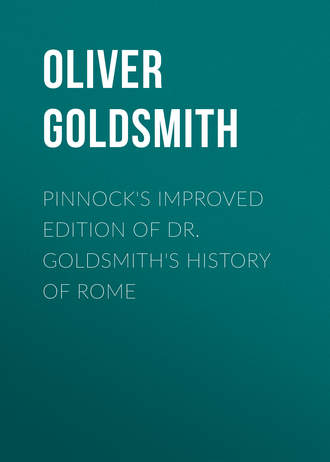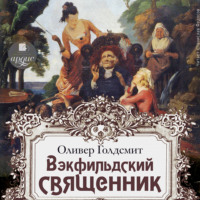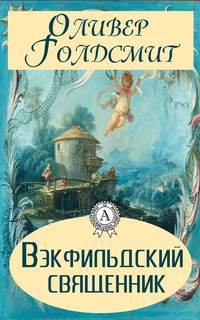 полная версия
полная версияPinnock's improved edition of Dr. Goldsmith's History of Rome

Oliver Goldsmith
Pinnock's improved edition of Dr. Goldsmith's History of Rome / to which is prefixed an introduction to the study of Roman history, and a great variety of valuable information added throughout the work, on the manners, institutions, and antiquities of the Romans; with numerous biographical and historical notes; and questions for examination at the end of each section. / By Wm. C. Taylor
PREFACE
The researches of Niebuhr and several other distinguished German scholars have thrown a new light on Roman History, and enabled us to discover the true constitution of that republic which once ruled the destinies of the known world, and the influence of whose literature and laws is still powerful in every civilized state, and will probably continue to be felt to the remotest posterity. These discoveries have, however, been hitherto useless to junior students in this country; the works of the German critics being unsuited to the purposes of schools, not only from their price, but also from the extensive learning requisite to follow them through their laborious disquisitions. The editor has, therefore, thought that it would be no unacceptable service, to prefix a few Introductory Chapters, detailing such results from their inquiries as best elucidate the character and condition of the Roman people, and explain the most important portion of the history. The struggles between the patricians and plebeians, respecting the agrarian laws have been so strangely misrepresented, even by some of the best historians, that the nature of the contest may, with truth, be said to have been wholly misunderstood before the publication of Niebuhr's work: a perfect explanation of these important matters cannot be expected in a work of this kind; the Editors trust that the brief account given here of the Roman tenure of land, and the nature of the agrarian laws, will be found sufficient for all practical purposes. After all the researches that have been made, the true origin of the Latin people, and even of the Roman city, is involved in impenetrable obscurity; the legendary traditions collected by the historians are, however, the best guides that we can now follow; but it would be absurd to bestow implicit credit on all the accounts they have given, and the editor has, therefore, pointed out the uncertain nature of the early history, not to encourage scepticism, but to accustom students to consider the nature of historical evidence, and thus early form the useful habit of criticising and weighing testimony.
The authorities followed in the geographical chapters, are principally Heeren and Cramer; the treatise of the latter on ancient Italy is one of the most valuable aids acquired by historical students within the present century. Much important information respecting the peculiar character of the Roman religion has been derived from Mr. Keightley's excellent Treatise on Mythology; the only writer who has, in our language, hitherto, explained the difference between the religious systems of Greece and Rome. The account of the barbarians in the conclusion of the volume, is, for the most part, extracted from "Koch's Revolutions of Europe;" the sources of the notes, scattered through the volume, are too varied for a distinct acknowledgment of each.
HISTORY OF ROME
INTRODUCTION
CHAPTER I.
GEOGRAPHICAL OUTLINE OF ITALY
Italia! oh, Italia! thou who hastThe fatal gift of beauty, which becameA funeral dower of present woes and past,On thy sweet brow is sorrow plough'd by shame,And annals traced in characters of flame. —Byron.1. The outline of Italy presents a geographical unity and completeness which naturally would lead us to believe that it was regarded as a whole, and named as a single country, from the earliest ages. This opinion would, however, be erroneous; while the country was possessed by various independent tribes of varied origin and different customs, the districts inhabited by each were reckoned separate states, and it was not until these several nations had fallen under the power of one predominant people that the physical unity which the peninsula possesses was expressed by a single name. Italy was the name originally given to a small peninsula in Brut'tium, between the Scylacean and Napetine gulfs; the name was gradually made to comprehend new districts, until at length it included the entire country lying south of the Alps, between the Adriatic and Tuscan seas. 2. The names Hespéria, Satúrnia, and Œnot'ria have also been given to this country by the poets; but these designations are not properly applicable; for Hespéria was a general name for all the countries lying to the west of Greece, and the other two names really belonged to particular districts.
3. The northern boundary of Italy, in its full extent, is the chain of the Alps, which forms a kind of crescent, with the convex side towards Gaul. The various branches of these mountains had distinct names; the most remarkable were, the Maritime Alps, extending from the Ligurian sea to Mount Vésulus, Veso; the Collian, Graian, Penine, Rhœtian, Tridentine, Carnic, and Julian Alps, which nearly complete the crescent; the Euganean, Venetian, and Pannonian Alps, that extend the chain to the east.
4. The political divisions of Italy have been frequently altered, but it may be considered as naturally divided into Northern, Central, and Southern Italy.
The principal divisions of Northern Italy were Ligu'ria and Cisalpine Gaul.
5. Only one half of Liguria was accounted part of Italy; the remainder was included in Gaul. The Ligurians originally possessed the entire line of sea-coast from the Pyrennees to the Tiber, and the mountainous district now called Piedmont; but before the historic age a great part of their territory was wrested from them by the Iberians, the Celts, and the Tuscans, until their limits were contracted nearly to those of the present district attached to Genoa. Their chief cities were Genúa, Genoa; Nicœ'a, Nice, founded by a colony from Marseilles; and As'ta, Asti. The Ligurians were one of the last Italian states conquered by the Romans; on account of their inveterate hostility, they are grossly maligned by the historians of the victorious people, and described as ignorant, treacherous, and deceitful; but the Greek writers have given a different and more impartial account; they assure us that the Ligurians were eminent for boldness and dexterity, and at the same time patient and contented.
6. Cisalpine Gaul extended from Liguria to the Adriatic or Upper Sea, and nearly coincides with the modern district of Lombardy. The country is a continuous plain divided by the Pa'dus, Po, into two parts; the northern, Gallia Transpada'na, was inhabited by the tribes of the Tauri'ni, In'subres, and Cenoma'nni; the southern, Gallia Cispada'na, was possessed by the Boi'i, Leno'nes, and Lingo'nes. 7. These plains were originally inhabited by a portion of the Etrurian or Tuscan nation, once the most powerful in Italy; but at an uncertain period a vast horde of Celtic Gauls forced the passage of the Alps and spread themselves over the country, which thence received their name.
8. It was sometimes called Gallia Toga'ta, because the invaders conformed to Italian customs, and wore the toga. Cisalpine Gaul was not accounted part of Italy in the republican age; its southern boundary, the river Rubicon, being esteemed by the Romans the limit of their domestic empire.
9. The river Pa'dus and its tributary streams fertilized these rich plains. The principal rivers falling into the Padus were, from the north, the Du'ria, Durance; the Tici'nus, Tessino; the Ad'dua, Adda; the Ol'lius, Oglio; and the Min'tius, Minzio: from the south, the Ta'narus, Tanaro, and the Tre'bia. The Ath'esis, Adige; the Pla'vis, Paive; fall directly into the Adriatic.
10. The principal cities in Cisalpine Gaul were Roman colonies with municipal rights; many of them have preserved their names unchanged to the present day. The most remarkable were; north of the Pa'dus, Terge'ste, Trieste; Aquilei'a; Pata'vium, Padua; Vincen'tia, Vero'na, all east of the Athe'sis: Mantua; Cremo'na; Brix'ia, Brescia; Mediola'num, Milan; Tici'num, Pavia; and Augusta Turino'rum, Turin; all west of the Athe'sis. South of the Po we find Raven'na; Bono'nia, Bologna; Muti'na, Modena; Par'ma, and Placen'tia. 11. From the time that Rome was burned by the Gauls (B.C. 390), the Romans were harassed by the hostilities of this warlike people; and it was not until after the first Punic war, that any vigorous efforts were made for their subjugation. The Cisalpine Gauls, after a fierce resistance, were overthrown by Marcell'us (B.C. 223) and compelled to submit, and immediately afterwards military colonies were sent out as garrisons to the most favourable situations in their country. The Gauls zealously supported An'nibal when he invaded Italy, and were severely punished when the Romans finally became victorious.
12. North-east of Cisalpine Gaul, at the upper extremity of the Adriatic, lay the territory of the Venetians; they were a rich and unwarlike people, and submitted to the Romans without a struggle, long before northern Italy had been annexed to the dominions of the republic.
13. Central Italy comprises six countries, Etru'ria, La'tium, and Campa'nia on the west; Um'bria, Pice'num, and Sam'nium, on the east.
14. Etru'ria, called also Tus'cia (whence the modern name Tuscany) and Tyrrhe'nia, was an extensive mountainous district, bounded on the north by the river Mac'ra, and on the south and east by the Tiber. The chain of the Apennines, which intersects middle and Lower Italy, commences in the north of Etru'ria. The chief river is the Ar'nus, Arno. 15. The names Etruscan and Tyrrhenian, indifferently applied to the inhabitants of this country, originally belonged to different tribes, which, before the historic age, coalesced into one people. The Etruscans appear to have been Celts who descended from the Alps; the Tyrrhenians were undoubtedly a part of the Pelas'gi who originally possessed the south-east of Europe. The circumstances of the Pelasgic migration are differently related by the several historians, but the fact is asserted by all.1 These Tyrrhenians brought with them the knowledge of letters and the arts, and the united people attained a high degree of power and civilization, long before the name of Rome was known beyond the precincts of Latium. They possessed a strong naval force, which was chiefly employed in piratical expeditions, and they claimed the sovereignty of the western seas. The first sea-fight recorded in history was fought between the fugitive Phocians,2 and the allied fleets of the Tyrrhenians and the Carthaginians (B.C. 539.)
16. To commerce and navigation the Etruscans were indebted for their opulence and consequent magnificence; their destruction was owing to the defects of their political system. There were twelve Tuscan cities united in a federative alliance. Between the Mac'ra and Arnus were, Pi'sæ, Pisa; Floren'tia, Florence; and Fæ'sulæ: between the Arnus and the Tiber, Volate'rræ, Volterra; Volsin'ii, Bolsena; Clu'sium, Chiusi; Arre'tium, Arrezzo; Corto'na; Peru'sia, Perugia, (near which is the Thrasamene lake); Fale'rii, and Ve'ii.
17. Each of these cities was ruled by a chief magistrate called lu'cumo, chosen for life; he possessed regal power, and is frequently called a king by the Roman historians. In enterprises undertaken by the whole body, the supreme command was committed to one of the twelve lucumones, and he received a lictor from each city. But from the time that Roman history begins to assume a regular form, the Tuscan cities stand isolated, uniting only transiently and casually; we do not, however, find any traces of intestine wars between the several states.
18. The Etrurian form of government was aristocratical, and the condition of the people appears to have been miserable in the extreme; they were treated as slaves destitute of political rights, and compelled to labour solely for the benefit of their taskmasters. A revolution at a late period took place at Volsin'ii, and the exclusive privileges of the nobility abolished after a fierce and bloody struggle; it is remarkable that this town, in which the people had obtained their rights, alone made an obstinate resistance to the Romans.
19. The progress of the Tuscans in the fine arts is attested by the monuments that still remain; but of their literature we know nothing; their language is unknown, and their books have perished. In the first ages of the Roman republic, the children of the nobility were sent to Etru'ria for education, especially in divination and the art of soothsaying, in which the Tuscans were supposed to excel. The form of the Roman constitution, the religious ceremonies, and the ensigns of civil government, were borrowed from the Etrurians.
20. La'tium originally extended along the coast from the Tiber to the promontory of Circe'ii; hence that district was called, old La'tium; the part subsequently added, called new La'tium, extended from Circeii to the Li'ris, Garigliano. The people were called Latins; but eastward, towards the Apennines, were the tribes of the Her'nici, the Æ'qui, the Mar'si, and the Sabines; and on the south were the Vols'ci, Ru'tuli, and Aurun'ci. The chief rivers in this country were the A'nio, Teverone; and Al'lia, which fall into the Tiber; and the Liris, Garigliano; which flows directly into the Mediterranean.
21. The chief cities in old Latium were ROME; Ti'bur, Tivoli; Tus'culum, Frescati; Al'ba Lon'ga, of which no trace remains; Lavin'ium; An'tium; Ga'bii; and Os'tia, Civita Vecchia; the chief towns in new Latium were Fun'di, Anx'ur or Terraci'na, Ar'pinum, Mintur'næ, and For'miæ.
22. CAMPA'NIA included the fertile volcanic plains that lie between the Liris on the north, and the Si'lanus, Selo, on the south; the other most remarkable river was the Voltur'nus, Volturno. The chief cities were, Ca'pua the capital, Linter'num, Cu'mæ, Neapo'lis, Naples; Hercula'neum, Pompe'ii, Surren'tum, Saler'num, &c. The original inhabitants of Campa'nia, were the Auso'nes and Op'ici or Osci, the most ancient of the native Italian tribes. The Tyrrhenian Pelas'gi made several settlements on the coast, and are supposed to have founded Cap'ua. The Etruscans were afterwards masters of the country, but their dominion was of brief duration, and left no trace behind. Campa'nia was subdued by the Romans after the Volscian war.
23. The soil of Campa'nia is the most fruitful, perhaps, in the world, but it is subject to earthquakes and volcanic eruptions. Mount Vesu'vius in the early ages of Italy was not a volcano; its first eruption took place A.D. 79.
24. UM'BRIA extended along the middle and east of Italy, from the river Rubicon in the north, to the Æ'sis, Gesano, dividing it from Pise'num, and the Nar, Nera, separating it from Sam'nium in the south. The Umbrians were esteemed one of the most ancient races in Italy, and were said to have possessed the greater part of the northern and central provinces. They were divided into several tribes, which seem to have been semi-barbarous, and they were subject to the Gauls before they were conquered by the Romans. Their chief towns were Arimi'nium, Rimini; Spole'tium, Spoleto; Nar'nia, Narni; and Ocricu'lum, Otriculi.
25. PICE'NUM was the name given to the fertile plain that skirts the Adriatic, between the Æ'sis, Gesano, and the Atar'nus, Pescara. The chief cities were Anco'na and Asc'ulum Pice'num, Ascoli. The Picentines were descended from the Sabines, and observed the strict and severe discipline of that warlike race, but they were destitute of courage or vigour.
26. SAM'NIUM included the mountainous tract which stretches from the Atar'nus in the north, to the Fren'to in the south. It was inhabited by several tribes descended from the Sabines3 and Ma'rsi, of which the Samnites were the most distinguished; the other most remarkable septs were the Marruci'ni and Pelig'ni in the north, the Frenta'ni in the east, and the Hirpi'ni in the south.
27. The Samnites were distinguished by their love of war, and their unconquerable attachment to liberty; their sway at one time extended over Campa'nia, and the greater part of central Italy; and the Romans found them the fiercest and most dangerous of their early enemies. The chief towns in the Samnite territory were Alli'fæ, Beneventum, and Cau'dium.
28. Lower Italy was also called Magna Græ'cia, from the number of Greek4 colonies that settled on the coast; it comprised four countries; Luca'nia and Brut'tium on the west, and Apu'lia and Cala'bria on the east.
29. LUCA'NIA was a mountainous country between the Sil'arus, Selo, on the north, and the Lä'us, Lavo, on the south. The Lucanians were of Sabine origin, and conquered the Œnotrians, who first possessed the country: they also subdued several Greek cities on the coast. The chief cities were Posido'nia or Pæstum, He'lia or Ve'lia, Sib'aris and Thu'rii.
30. Brut'tium is the modern Cala'bria, and received that name when the ancient province was wrested from the empire. It included the tongue of land from the river Läus to the southern extremity of Italy at Rhe'gium. The mountains of the interior were inhabited by the Bruta'tes or Brut'tii, a semi-barbarous tribe, at first subject to the Sibarites, and afterwards to the Lucanians. In a late age they asserted their independence, and maintained a vigorous resistance to the Romans. As the Brut'tii used the Oscan language, they must have been of the Ausonian race. The chief towns were the Greek settlements on the coast, Consen'tia, Cosenza; Pando'sia, Cirenza; Croto'na, Mame'rtum, Petil'ia, and Rhe'gium, Reggio.
31. Apu'lia extended along the eastern coast from the river Fren'to, to the eastern tongue of land which forms the foot of the boot, to which Italy has been compared. It was a very fruitful plain, without fortresses or harbours, and was particularly adapted to grazing cattle. It was divided by the river Au'fidus, Ofanto, into Apu'lia Dau'nia, and Apu'lia Peuce'tia, or pine-bearing Apu'lia. The chief towns were, in Dau'nia, Sipon'tum and Luce'ria: in Peuce'tia, Ba'rium, Can'næ, and Venu'sia.
32. Cala'bria, or Messa'pia, is the eastern tongue of land which terminates at Cape Japy'gium, Santa Maria; it was almost wholly occupied by Grecian colonies. The chief towns were Brundu'sium, Brindisi: Callipolis, Gallipoli: and Taren'tum.
33. The islands of Sicily, Corsica, and Sardinia, which are now reckoned as appertaining to Italy, were by the Romans considered separate provinces.
Questions for Examination.
1. How is Italy situated?
2. By what names was the country known to the ancients?
3. How is Italy bounded on the north?
4. What districts were in northern Italy?
5. What was the extent of Liguria, and the character of its inhabitants?
6. How was Cisalpine Gaul divided?
7. By whom was Cisalpine Gaul inhabited?
8. Why was it called Togata?
9. What are the principal rivers in northern Italy?
10. What are the chief cities in Cisalpine Gaul?
11. When did the Romans subdue this district?
12. Did the Venetians resist the Roman power?
13. What are the chief divisions of central Italy?
14. How is Etruria situated?
15. By what people was Etruria colonized?
16. What were the Tuscan cities?
17. How were the cities ruled?
18. What was the general form of Tuscan government?
19. For what were the Tuscans remarkable?
20. What was the geographical situation of Latium?
21. What were the chief towns in Latium?
22. What towns and people were in Campania?
23. For what is the soil of Campania remarkable?
24. What description is given of Umbria?
25. What towns and people were in Picenum?
26. From whom were the Samnites descended?
27. What was the character of this people?
28. How was southern Italy divided?
29. What description is given of Lucania?
30. By what people was Bruttium inhabited?
31. What is the geographical situation of Apulia?
32. What description is given of Calabria?
33. What islands belong to Italy?
CHAPTER II.
THE LATIN LANGUAGE AND PEOPLE – CREDIBILITY OF THE EARLY HISTORY
Succeeding times did equal folly call.Believing nothing, or believing all. —Dryden.The Latin language contains two primary elements, the first intimately connected with the Grecian, and the second with the Oscan tongue; to the former, for the most part, belong all words expressing the arts and relations of civilized life; to the latter, such terms as express the wants of men before society has been organized. We are therefore warranted in conjecturing that the Latin people was a mixed race; that one of its component parts came from some Grecian stock, and introduced the first elements of civilization, and that the other was indigenous, and borrowed refinement from the strangers. The traditions recorded by the historians sufficiently confirm this opinion; they unanimously assert that certain bodies of Pelasgi came into the country before the historic age, and coalesced with the ancient inhabitants. The traditions respecting these immigrations are so varied, that it is impossible to discover any of the circumstances; but there is one so connected with the early history of Rome, that it cannot be passed over without notice. All the Roman historians declare, that after the destruction of Troy, Æneas, with a body of the fugitives, arrived in Latium, and having married the daughter of king Lati'nus, succeeded him on the throne. It would be easy to show that this narrative is so very improbable, as to be wholly unworthy of credit; but how are we to account for the universal credence which it received? To decide this question we must discuss the credibility of the early Roman history, a subject which has of late years attracted more than ordinary attention.
The first Roman historian of any authority, was Fa'bius Pic'tor, who flourished at the close of the second Punic war; that is, about five centuries and a half after the foundation of the city, and nearly a thousand years after the destruction of Troy. The materials from which his narrative was compiled, were the legendary ballads, which are in every country the first record of warlike exploits; the calendars and annals kept by the priests, and the documents kept by noble families to establish their genealogy. Imperfect as these materials must necessarily have been under any circumstances, we must remember that the city of Rome was twice captured; once by Porsenna, and a second time by the Gauls, about a century and a half before Fabius was born. On the latter occasion the city was burned to the ground, and the capital saved only by the payment of an immense ransom. By such a calamity it is manifest that the most valuable documents must have been dispersed or destroyed, and the part that escaped thrown into great disorder. The heroic songs might indeed have been preserved in the memory of the public reciters; but there is little necessity for proving that poetic historians would naturally mingle so much fiction with truth, that few of their assertions could be deemed authentic. The history of the four first centuries of the Roman state is accordingly full of the greatest inconsistences and improbabilities; so much so, that many respectable writers have rejected the whole as unworthy of credit; but this is as great an excess in scepticism, as the reception of the whole would be of credulity. But if the founders of the city, the date of its erection, and the circumstances under which its citizens were assembled be altogether doubtful, as will subsequently be shown, assuredly the history of events that occurred four centuries previous must be involved in still greater obscurity. The legend of Æneas, when he first appears noticed as a progenitor of the Romans, differs materially from that which afterwards prevailed. Romulus, in the earlier version of the story, is invariably described as the son or grandson of Æneas. He is the grandson in the poems of Nævius and Ennius, who were both nearly contemporary with Fabius Pictor. This gave rise to an insuperable chronological difficulty; for Troy was destroyed B.C. 1184, and Rome was not founded until B.C. 753. To remedy this incongruity, a list of Latin kings intervening between Æne'as and Rom'ulus, was invented; but the forgery was so clumsily executed, that its falsehood is apparent on the slightest inspection. It may also be remarked, that the actions attributed to Æneas are, in other traditions of the same age and country, ascribed to other adventurers; to Evander, a Pelasgic leader from Arcadia, who is said to have founded a city on the site afterwards occupied by Rome; or to Uly'sses, whose son Tele'gonus is reported to have built Tus'culum.










